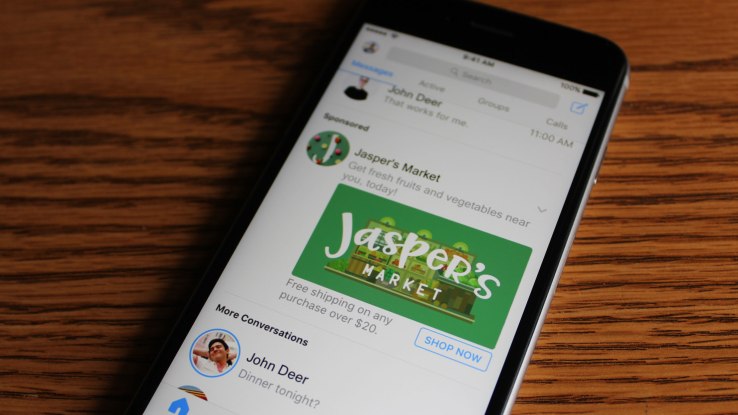

Messaging is the center of mobile, and Facebook wants ads in front of all those eyes. After seeing “promising results from Australia and Thailand,” Facebook Messenger is expanding its display ad beta test that lets businesses buy space between your chat threads. Later this month, a small percentage of users will start seeing ads in the Messenger app’s home tab.
Facebook tells TechCrunch that where these ads appear in the inbox “depends on how many threads a user has, the size of their phone’s physical screen and the pixel density of the display.”
Over the next month, Facebook will gradually roll out Messenger ads to all advertisers globally. They’ll have the ability to buy through the Ads Manager or Power Editor, with Messenger becoming one of the automatic placements for Facebook ads alongside the main Facebook app, Instagram and the Audience Network of other apps and sites. Ads aren’t targeted by what people write in messages, and instead use the same Facebook targeting, measurement tools and minimum 50 percent pixels in view standard for viewability.

Facebook began testing the Messenger display ads in January, though the design has evolved from horizontally scrolling carousel design to single display ad design. This makes sense since Messenger’s recent redesign gave people tabs they could swipe through, which could have been accidentally triggered by people swiping through the ads.
The display ads are the most traditional way that Facebook is trying to monetize its 1.2 billion user Messenger app. As Facebook runs out of ad inventory in its News Feed, which it’s warned could slow the company’s revenue growth, it’s seeking to put ads on more of its properties.
Back in April 2016, Facebook started testing Sponsored Messages from brands you’ve already talked to before rolling them out to all developers. And Click To Message ads that send people from Facebook’s News Feed into a conversation with a brand started appearing in 2015.
The new Messenger display ads can lead to a website that’s rendered in the app’s internal browser. Alternatively, they can work like Click To Message ads, initiating a message thread with a company so they can convince you to buy something. Then, because you’ve already begun chatting with them, they’re eligible to send you Sponsored Messages in the future.
“Expect Facebook to roll these out slowly, as they normally do, but integrate payments and M, which is what makes the Messenger platform special,” says Facebook ads expert and CTO of BlitzMetrics Dennis Yu. “This is where Facebook and Amazon compete to enable frictionless commerce, so hold onto your horses for a wild ride!”
Yu is referring to the opportunity for Facebook to let you buy things straight through Messenger thanks to its in-app payment system used for peer-to-peer money transfers, and to use its M artificial intelligence assistant to make recommendations for when it recognizes that your texts signal that you might want to buy something.

For some, the Messenger ads will feel obtrusive, crammed in alongside your personal messages. There’s no way to permanently turn off Messenger ads, but you can tap the downward arrow in the bottom right of an ad to see options to report or hide it.
But at least they aren’t masquerading as real content like the Sponsored Messages. If Facebook can avoid putting too many of these in the inbox, and only show them after a sufficient number of threads, they could help it monetize without significantly changing the feel of Messenger.

